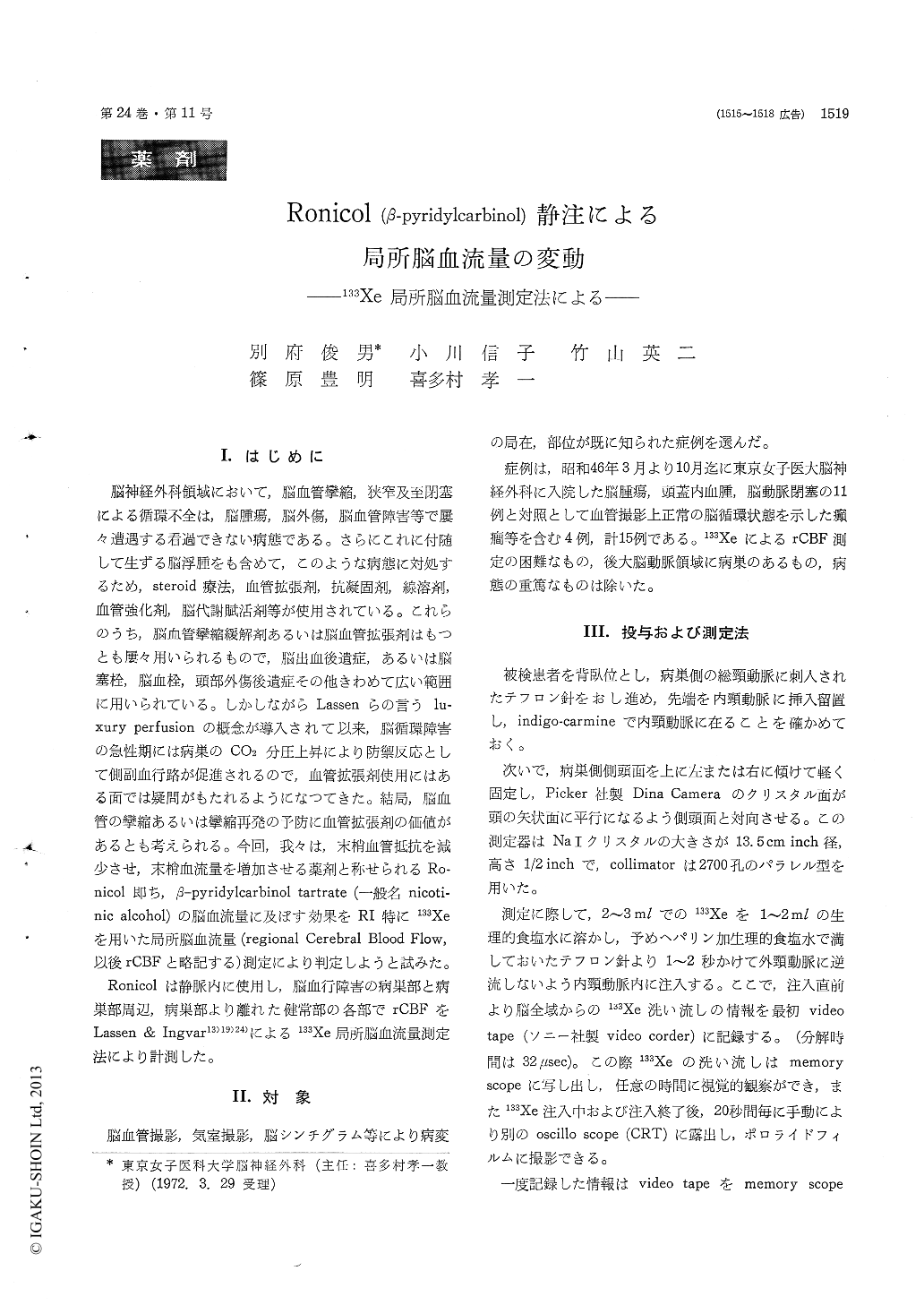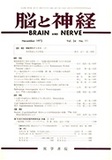Japanese
English
- 有料閲覧
- Abstract 文献概要
- 1ページ目 Look Inside
I.はじめに
脳神経外科領域において,脳血管攣縮,狭窄及至閉塞による循環不全は,脳腫瘍,脳外傷,脳血管障害等で屡々遭遇する看過できない病態である。さらにこれに付随して生ずる脳浮腫をも含めて,このような病態に対処するため,steroid療法,血管拡張剤,抗凝固剤,線溶剤,血管強化剤,脳代謝賦活剤等が使用されている。これらのうち,脳血管攣縮緩解剤あるいは脳血管拡張剤はもつとも厘々用いられるもので,脳出血後遺症,あるいは脳塞栓,脳血栓,頭部外傷後遺症その他きわめて広い範囲に用いられている。しかしながらLassenらの言うlu—xury perfusionの概念が導入されて以来,脳循環障害の急性期には病巣のCO2分圧上昇により防禦反応として側副血行路が促進されるので,血管拡張剤使用にはある面では疑問がもたれるようになつてきた。結局,脳血管の攣縮あるいは攣縮再発の予防に血管拡張剤の価値があるとも考えられる。今回,我々は,末梢血管抵抗を減少させ,末梢血流量を増加させる薬剤と称せられるRo—nicol即ち,β-pyridylcarbinol tartrate (一般名nicoti—nic alcohol)の脳血流量に及ぼす効果をRI特に133Xeを用いた局所脳血流量(regional Cerebral Blood Flow,以後rCBFと略記する)測定により判定しようと試みた。
Ronicolは静脈内に使用し,脳血行障害の病巣部と病巣部周辺,病巣部より離れた健常部の各部でrCBFをLassen & Ingvar13)19)24)による133Xe局所脳血流量測定法により計測した。
The effect of Ronicol (β-pyridylcarbinol tartrate) was investigated as a vasodilator drug by Heyek in 1962. In 11 patients who had regional circula-tory disturbance, regional cerebral blood fiow (rCBF) was measured by external recording gamma emitting tracer (133Xenon), injected into the internal carotid artery before and after the clinical appli-cation of Ronicol injection intravenously.
Evaluation of rCBF measured by means of data-store play back system : Our results were as followed ;
1) The quantitative changes on rCBF after the intravenous application of Ronicol 100mg werecalculated in the normal control group. It appeared possible to present a slight increase (averaged 10%-14%) of rCBF, which showed maximal level in 20min. after Ronicol injection.
2) We had measured the influence on the rCBF of focal, perifocal hyperemic zone and non-focal region respectively in 11 cases of organic brain diseases (including 5 brain tumors, 2 epidural hematomas, 1 aneurysm, 1 A-V malformation and 2 thromboses) after the application of Ronical (100mg or 50mg). On group injected by Ronicol 100mg, reduction of rCBF (averaged -10%~-16 %) was moderately revealed in the focal area. On the contrary, it seemed to be appeared the signifi-cant increase (averaged 19%- 26%) of rCBF in the perifocal area and also, very slight increase (averaged 2%- 6%) was found in the non-focal area.
On group injected by Ronicol 50mg, the changes of rCBF on each area seemed to be a similar tendency except for more slight increase (averaged 4%- 9%) of rCBF in the perifocal area than that of the subjects injected by Ronicol 100mg. Increase of rCBF, which showed the maximal level in 20 min. after the injection of Ronicol was observed significantly at the peri-focal and non-focal region, mainly at the perifocal area.
3) Mean arterial pressure and puls rate after administration of Ronicol were not so significant.
4) As for side effects of Ronicol injection, 14 of 25 cases (56%) complained of transient episodes of erythema and redness in the face, neck and trunk and also a few cases were suffered from heat sensation, urticaria and slight headache.
To conclude this very brief summary of our in-vestigation, we can say that Ronicol seems to be more effective to relieve for cerebral blood circula-tion disturbance as vasodilation drug especially to the peri-focal area (hyperemic region) of the organic brain diseases.

Copyright © 1972, Igaku-Shoin Ltd. All rights reserved.


